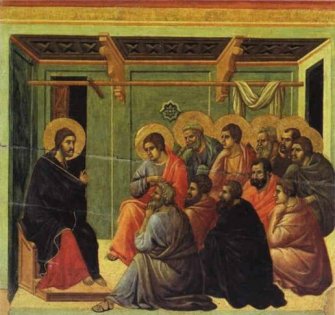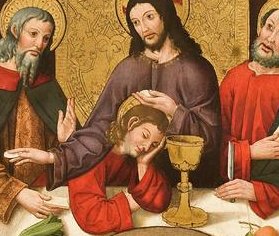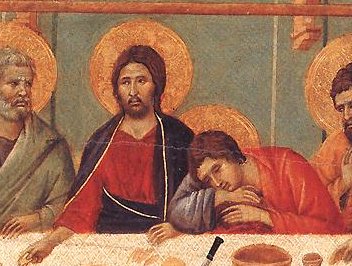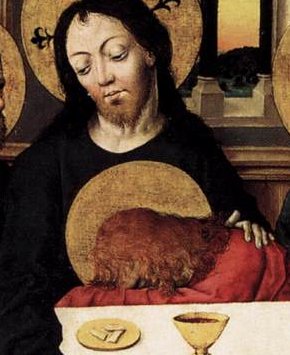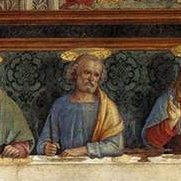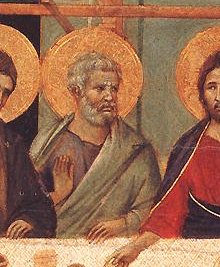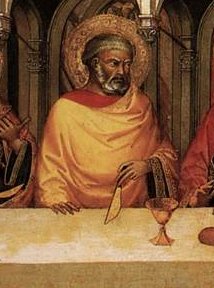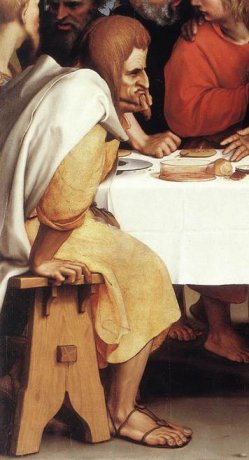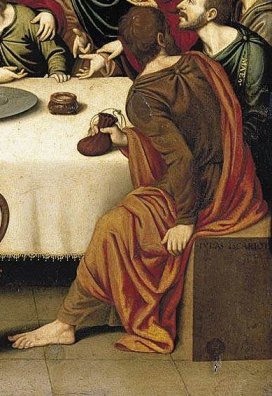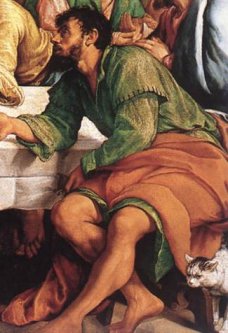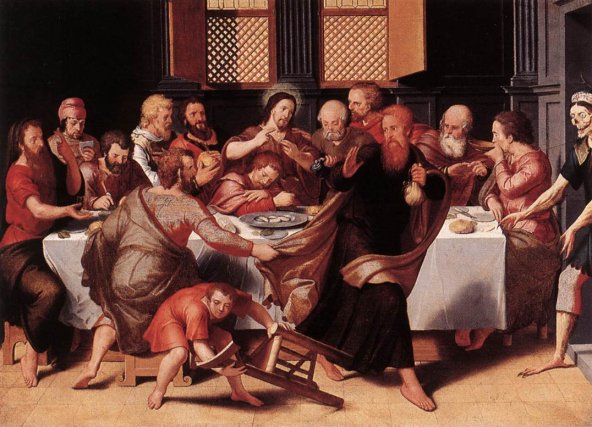|
The Passion of Christ |
||
|
The Last Supper - page 1 |
||
|
The Last supper is a complex event. Once again, John’s gospel is
different in a number of respects from the synoptic gospels. The date In the synoptic gospels, the Last Supper is eaten as the Passover feast. (Nisan 15) John's gospel moves the events a day earlier, (Nisan 14) the day on which the paschal lamb was slaughtered, so that the Last Supper and the crucifixion happen before the Passover. Effectively, Jesus became the Paschal Lamb, the Passover sacrifice. Note that, as far as the Passover is concerned, ‘day’ begins and ends in the evening, not at midnight. Images which include a cooked lamb on the table agree with the Synoptics, but not with John. It has to be said that most artists’ attempts at painting a convincing roast lamb are pretty unconvincing! The
Eucharist The
events |
||
|
|
||
|
All four gospels mention the
betrayal by Judas and the prediction of Peter’s denial of Christ. 'Now when the even was come, he sat down with the twelve. And as they did eat, he said, Verily I say unto you, that one of you shall betray me. And they were exceeding sorrowful, and began every one of them to say unto him, Lord, is it I? And he answered and said, He that dippeth his hand with me in the dish, the same shall betray me. The Son of man goeth as it is written of him: but woe unto that man by whom the Son of man is betrayed! it had been good for that man if he had not been born. Then Judas, which betrayed him, answered and said, Master, is it I? He said unto him, Thou hast said. And as they were eating, Jesus took bread, and blessed it, and brake it, and gave it to the disciples, and said, Take, eat; this is my body. And he took the cup, and gave thanks, and gave it to them, saying, Drink ye all of it; For this is my blood of the new testament, which is shed for many for the remission of sins.' (Mathew Ch 26 v 20 – 28) Visually, these statements by Christ call forth quite opposite reactions; alarm and disbelief on one hand, and quiet contemplation on the other. So is it possible to combine both elements in one picture? Leo Steinberg in The Incessant Last Supper has some interesting things to say about this in relation to what is probably the best known version, that by Leonardo, and we’ll look at this later. The Disciples How do we know which disciple is which? Images of the last supper are narratives rather than devotional paintings and so it is not appropriate, by and large, to give the apostles their identifying attributes – St.Peter’s keys, for example. Nevertheless there are clues. John the Evangelist is easy - Now there was leaning on Jesus' bosom one of his disciples, whom Jesus loved. John Ch 13 v23) |
||
|
|
|
|
|
Despite
anything you may have read by Dan Brown, and others, this always has been
John, traditionally young and with long hair. St Peter is usually easy to spot; quite close to Christ, elderly with a short white beard. Sometimes he holds a knife, appropriate for a meal but also prefiguring the ear-slicing he will be responsible for in the Garden of Gethsemane. |
||
|
|
|
|
|
Judas is generally easy to find too. Often an unattractive figure, he
may be shown on the nearside of the table, and will frequently be
clutching a purse. This is clearly a symbol of the bribe, but John tells
us that the other disciples thought the best of Judas: 'For some of them thought, because Judas had the bag, that Jesus had said unto him, But those things that we have need of against the feast; or, that he should give something to the poor'. (Ch13 v29) In early versions, such as those above, the lack of a halo is another giveaway. Cats may sometimes be seen hanging around the feet of Judas. Sadly, cats are regarded as symbols of treachery, which, on behalf of my very loyal cat, I rather object to. |
||
|
|
|
|
|
The painting below, by Pieter Pourbus, is possibly the silliest ever representation of Judas, who, tempted by Satan in what looks like a frilly dress and a tiara, rushes out, knocking over his chair in the process. An ultra-efficient servant is picking up the chair, while one of the disciples grabs his cloak to stop him going. I'm not sure which of the gospels this is based on. |
||
|
|
||
| I'm aware that someof the images on this page are details. You will find complete versions on the Web Gallery of Art. | ||
